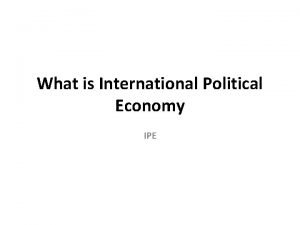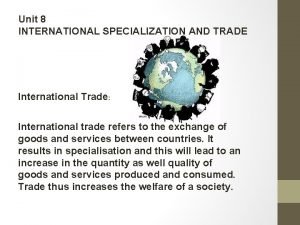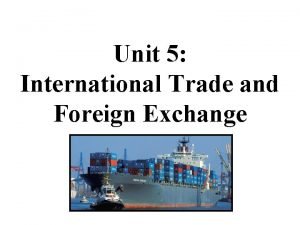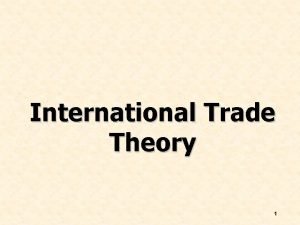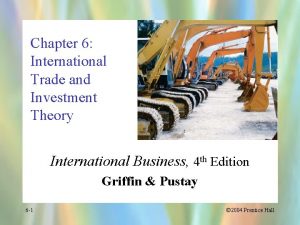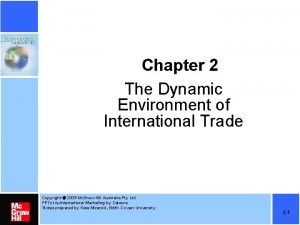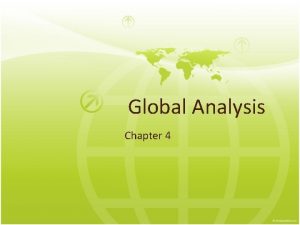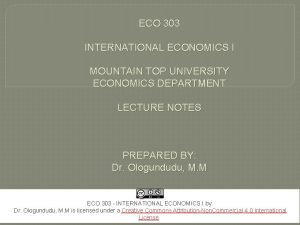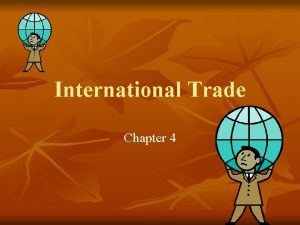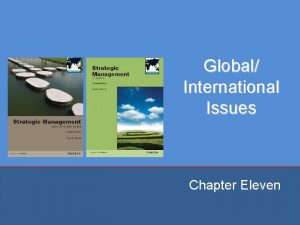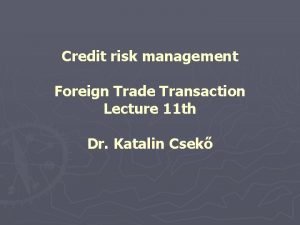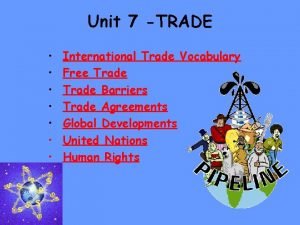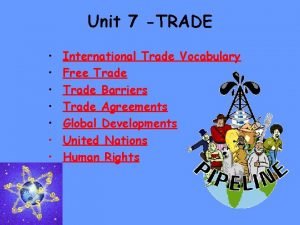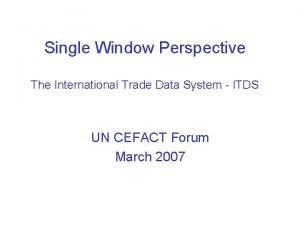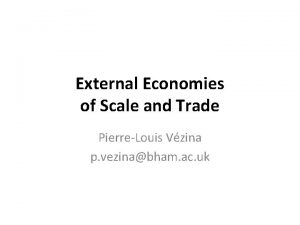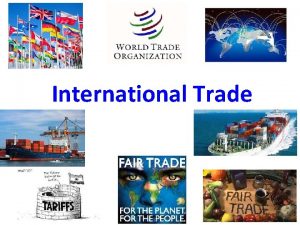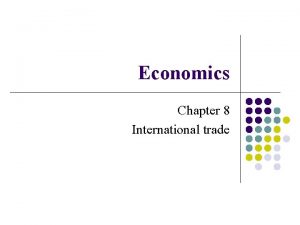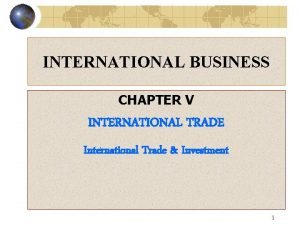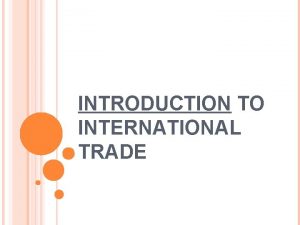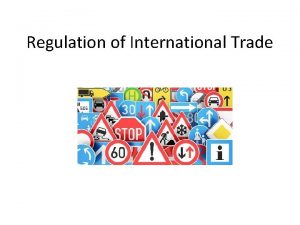INTRODUCTION TO INTERNATIONAL TRADE Lecturer PierreLouis Vzina p




















































- Slides: 52

INTRODUCTION TO INTERNATIONAL TRADE Lecturer: Pierre-Louis Vézina (p. vezina@bham. ac. uk)

This module • 10 weeks to understand how countries gain from trade – Week 1: An overview of world trade – Week 2 -7: Sources of gains from trade – Week 8 -10: Trade policy • Syllabus up on canvas!

Good to know • Book: International Economics, Theory and Policy, Paul Krugman, Maurice Obstfeld, Marc J. Melitz. , 9 th Edition, Pearson. • E-copy available from the library • Slides will be uploaded on canvas before the lecture

Good to know • Lectures: – Monday 5 -6 pm, , Poynting Building LT (S 02) – Friday 11 am-12 pm, (Education Building Vaughn Jeffries LT) • Office hours – Monday 2 -4 pm – Friday 1. 30 -2. 30 pm,

Good to know • TA for classes: Liyun Zhang • Classes: – three for each student – sign up via Canvas

Good to know • Assessment: 80% summer exam, 20% test (Week 9).

Week 1 1. An overview of world trade 2. The gravity model 3. The border effect

An overview of world trade • 5 facts about world trade: – 1: Since 1960, world trade has become a much larger part of the world economy



An overview of world trade • 5 facts about world trade: – 1: Since 1960, world trade has become a much larger part of the world economy – 2: Almost 60% of trade is manufacturing goods

2005 world trade

Changing composition of developingcountry exports


An overview of world trade • 5 facts about world trade: – 1: Since 1960, world trade has become a much larger part of the world economy – 2: Almost 60% of trade is manufacturing goods – 3: International supply chains boost trade


This is due to production fragmentation • Example: £ 500 i. Pad may involve £ 800 of trade – Japan makes the £ 100 screen, exports it to China – Korea makes the £ 200 chip, exports it China – China assembles chip and screen, exports the £ 500 i. Pad to the US • World imports = China imports (£ 100+£ 200=£ 300) + US imports (£ 500) = £ 800 • World GDP = £ 500 i. Pad

An overview of world trade • 5 facts about world trade: – 1: Since 1960, world trade has become a much larger part of the world economy – 2: Almost 60% of trade is manufacturing goods – 3: International supply chains boost trade – 4: 90% of world trade is by sea







An overview of world trade • 5 facts about world trade: – 1: Since 1960, world trade has become a much larger part of the world economy – 2: Almost 60% of trade is manufacturing goods – 3: International supply chains boost trade – 4: 90% of world trade is by sea – 5: Technology has greatly reduced trade costs


"One of the most significant, yet least noticed, economic developments of the last few decades… Containerization slashed the cost of transporting goods around the world and made the boom in global trade possible”




An overview of world trade • 5 facts about world trade: – 1: Since 1960, world trade has become a much larger part of the world economy – 2: Almost 60% of trade is manufacturing goods – 3: International supply chains boost trade – 4: 90% of world trade is by sea – 5: Technology has greatly reduced trade costs

Week 1 1. An overview of world trade 2. Who trades with whom? The gravity model

The gravity model

The gravity model

The gravity model • Newton’s Law: Any two bodies in the universe attract each other with a force that is directly proportional to the product of their masses and inversely proportional to the square of the distance between them.

The gravity model • The gravity model also explains international trade! • Size (GDP) and distance determine bilateral trade across countries

The gravity model • • • Xni are exports from n to i Yi and Yn are exporter and importer GDPs Dni is distance from i to n G is a constant In most estimations a ≈ b ≈ c ≈ 1

“The gravity model” • Gravity Law: Holding constant the product of two countries’ sizes, their bilateral trade will, on average, be inversely proportional to the distance between them.

The gravity model • Gravity models have produced some of the clearest and most robust findings in economics

The gravity model

The gravity model

The gravity model

The gravity model • Has globalization brought the death of distance?

The gravity model

Week 1 1. An overview of world trade 2. Who trades with whom? The gravity model 3. The border effect

The border effect • Trade between countries is harder than trade between regions within a country • Economists have coined how harder it is “the border effect”, as it involves crossing an international border • The border effect is the empirical regularity that trade is much higher within countries than across country borders

The border effect • Example: – Do US States and Canadian provinces trade as much between them when goods have to cross the border? – We can answer this question by looking at how much Canadian provinces and US States at similar distances trade with British Columbia


The border effect Crossing the border reduces trade by 80%

The border effect • Why do borders reduce trade? – Tariffs – Administrative barriers (docs) – Currency exchange – Cultural barriers – …? • The border effect can also be thought of as a home bias, i. e. a preference for home goods over foreign ones


Extra readings • Head, K. and Mayer, T. (2013), What separates us? Sources of resistance to globalization. Canadian Journal of Economics, 46: 1196– 1231.
 Lecturer's name
Lecturer's name Vzina
Vzina Vzina
Vzina Vzina
Vzina Jeannie watkins
Jeannie watkins Spe distinguished lecturer
Spe distinguished lecturer Good morning students
Good morning students Photography lecturer
Photography lecturer Lecturer in charge
Lecturer in charge Designation lecturer
Designation lecturer Designation of lecturer
Designation of lecturer Gcwak
Gcwak Lecturer name
Lecturer name Pearson lecturer resources
Pearson lecturer resources Spe distinguished lecturer
Spe distinguished lecturer Lector vs lecturer
Lector vs lecturer Lecturer in charge
Lecturer in charge Cfa lecturer handbook
Cfa lecturer handbook Lecturer asad ali
Lecturer asad ali Trade diversion and trade creation
Trade diversion and trade creation Umich
Umich Trade diversion and trade creation
Trade diversion and trade creation The trade in the trade-to-gdp ratio
The trade in the trade-to-gdp ratio Fair trade not free trade
Fair trade not free trade Trade diversion and trade creation
Trade diversion and trade creation Liner vs tramp
Liner vs tramp Triangular slave trade
Triangular slave trade Ipe liberalism
Ipe liberalism Unit 8
Unit 8 International trade and foreign exchange
International trade and foreign exchange Mercantilism
Mercantilism Current theory of international trade adalah
Current theory of international trade adalah Strategic trade theory
Strategic trade theory International trade theory
International trade theory International trade theory
International trade theory Chapter 6 theories of international trade and investment
Chapter 6 theories of international trade and investment Global strategic rivalry theory of international trade
Global strategic rivalry theory of international trade Importance of international trade
Importance of international trade Dynamic environment of international marketing
Dynamic environment of international marketing Certificate in international trade and finance citf
Certificate in international trade and finance citf Trade definition
Trade definition Chapter 4 global analysis
Chapter 4 global analysis Eco 303
Eco 303 Local guide program
Local guide program Nature of international trade
Nature of international trade Disadvantages of international trade
Disadvantages of international trade Credit risk in international trade
Credit risk in international trade Supplier blue genipa
Supplier blue genipa Advantages of international trade
Advantages of international trade Trade vocabulary
Trade vocabulary Trade vocabulary
Trade vocabulary International trade data system
International trade data system Explain recent trends in india's foreign trade
Explain recent trends in india's foreign trade



























